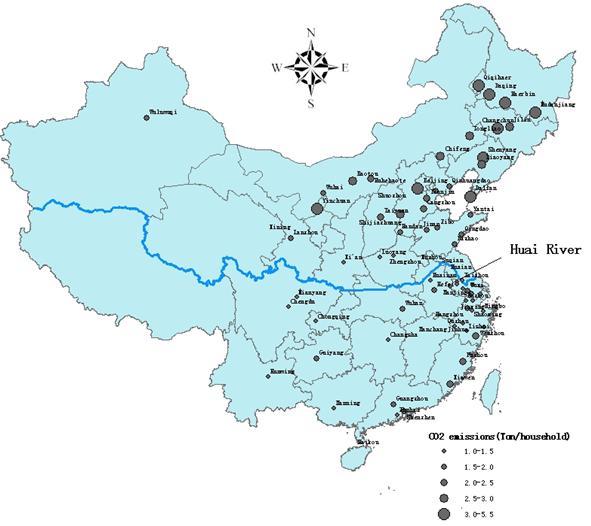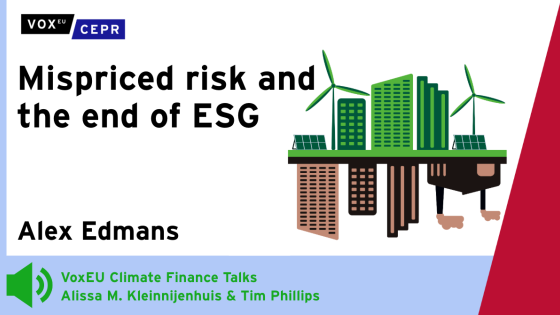China’s economic growth has profound environmental implications. Past research has examined the them using an Environmental Kuznets Curve framework either using national panel data (see Schmalensee et al 1998) or using regional aggregate data. Auffhammer and Carson (2008) create a panel data set for 30 Chinese provinces covering the years 1985 to 2004. Today, per capita carbon emissions in the US are about five times the per capita emissions in China. If China’s per capita greenhouse gas emissions rose to US levels, then global carbon emissions would increase by more than 50%.
While 40% of US emissions are associated with residential and personal transportation, a much smaller share of Chinese emissions come from these sectors. But the household’s share of total per-capita carbon emissions will surely grow as China changes from a manufacturing economy to a service economy, and as China’s urban population continues to grow fast and the urban residents become richer and richer. China will consume more electricity and the demand for private transportation services will increase.
In recent research (jointly with Rui Wang and Edward Glaeser), we calculate household carbon emissions using several data sources including the Chinese Urban Household Survey. This survey provides information on energy usage for 25,000 households across 74 cities. Relative to US households, transportation represents a smaller share of Chinese urban household emissions and household heating represents a much larger share – a poorer country can do without air conditioning and cars, but not without winter warmth.
Urban infrastructure is long-lived, and decisions made decades ago still shape older cities like London and New York. Today, China is making choices over investments in roads, public transit, electricity generation and housing that will have implications for resource consumption and greenhouse gas production for decades. The combination of irreversibility of investment, and China’s vast size, makes its current regional development decisions relevant for long-term global carbon emissions.
China currently has three significant regional policies, which support growth in the Northeast, the Western hinterland and the Beijing-Tianjin-Bohai Sea region. Relative to the average city’s household, carbon emissions are 69% higher in the Northeast, 40% higher in the Beijing-Tianjin-Bohai Sea region and 17% lower in the West. These findings suggest that regional development policies that favour growth in the Northeast and in the greater Beijing areas are likely to increase China’s overall residential carbon emissions.
Measuring greenhouse gas emissions in China’s major cities
We estimate how much carbon dioxide emissions a standardised Chinese household produces per year if it resides within one of China’s 74 cities, including all the 35 major cities plus some cities that have enough sample observations. We focus on the effect of four major household sources of carbon dioxide emissions, as measured in tons of carbon dioxide. These four are:
- Transportation
- Residential electricity consumption
- Residential heating
- Domestic fuel.
First, transportation represents energy use from a vector of activities including litres of annual gasoline consumed for households who own a car. Transportation also includes miles travelled on cabs, and the energy use of buses and subways. All forms of transportation energy uses are multiplied by an emissions factor vector. For example, each litre of #93 gasoline consumed produces 2.226 Kg of carbon dioxide.
Second, we examine carbon dioxide emissions from residential electricity consumption. Total carbon dioxide produced as a byproduct of electricity generation depends on a region’s power plant emissions factor. This is defined as γ2. Regions that use more coal for power generation have a higher emissions factor.
Third, our focus on residential heating highlights the fact that winter temperatures in China’s cities differ greatly. Northern cities are much colder than southern cities. In cities north of the Huai River and Qinling Mountains, heat is provided publicly through a system that provides a fixed amount of heating between November 15 and March 15. This “centralised heating system” prevents individual households from controlling the indoor temperature themselves. Southern cities, however, are not entitled to centralised heating. Given this, we assume that energy usage for heating is proportional to the floor area of the home. This sector creates high level of emissions because of heating’s main energy source is coal (Almond et. al., 2009).
Fourth, domestic fuels includes three components: coal, liquefied petroleum gas, and coal gas. Coal is inexpensive, but it is carbon intensive. A byproduct of using it is elevated ambient air pollution level such as sulfur dioxide, and particulates. Liquefied petroleum gas and coal gas are extracted from petroleum oil and coal, and are much cleaner and less carbon intensive.
China’s greenest cities based on the household CO2 metric
To measure the carbon emissions of our 74 Chinese cities based on carbon dioxide emissions, we use the estimated city-specific energy consumptions for seven energy types for a standardised household and then convert that energy use into carbon dioxide emissions. The standardised household is defined as a household with an annual income of 40,000 Yuan or $5,714, three members and a household head of 45 years old, which are the means of these three variables of the whole sample. By predicting the carbon dioxide emission of a standardised household, we are able to answer: “if a household moved from city a to city b, would aggregate carbon emissions rise or fall?”
In Table 1 we rank China’s 74 major cities by total carbon emission per standardised household. China’s major cities’ household carbon emissions are dramatically lower than in the US. Glaeser and Kahn (2010) report that in the cleanest cities of San Diego and San Francisco, a standardised household emits around 26 tons of CO2 per year – albeit with a much higher standard income of $62,500. Shanghai’s standardised household, meanwhile, produces 1.8 tons of carbon and Beijing’s standardised household produces 4.0 tons. Even in China’s brownest city, Daqing, a standardised household emits only one-fifth of the carbon produced by one in America’s greenest cities.
Figure 1 shows the per household carbon dioxide emissions in each of the 74 cities. High levels of carbon emissions are particularly common in the north, which reflects the cold temperatures and government heating policy. Coastal cities also have higher emissions, perhaps because they are somewhat more developed. Eight of the ten greenest cities in our sample are located just south of the centralised heating border in the coastal provinces. These cities are not entitled to winter heating services and their summers are not exceptionally hot. Daqing, China’s oil capital, has dramatically higher carbon emissions than any other city.
Figure 1. Carbon dioxide emissions per household in 74 Chinese cities
The Chinese heating system is coal-based and highly subsidised. Most of the heat is derived from coal-fired heat-only boilers or combined heat and power generators, which are inefficient in energy usage compared to electric, gas and oil heating systems in industrial countries (Yi Jiang 2007). If China’s home heating system were to be dramatically changed, perhaps using far less carbon intensive energy sources, then this could certainly change the rankings of cities.
The results reported in Table 1 are measured in tons of carbon dioxide per household. We use an estimate of $35 per ton as the marginal social cost of one ton of carbon dioxide. This is a conservative estimate relative to the Stern report (2008), which suggests a cost of carbon dioxide that is twice this amount. This value lies in the middle of the range reported by Metcalf (2007).
We estimate that moving the average household from the greenest city to the brownest would cause a social externality of $136.5 per year – roughly 2.5% of a year’s income. If the northern cities substitute away from coal for home heating, or if the richer cities invest more in subways or other forms of transit, this gap could narrow.
China’s regional development policy
Unlike the US, China’s government is pursuing a well defined set of regional growth policies. If successful, these policies will affect China’s overall carbon emissions. In China, there are at least three significant programmes that are intended to bolster the growth of particular regions.
- The Western Development Programme launched in 1999 gives infrastructure aid and support for industrial adjustment to western and inland provinces.
- The Northeast Revitalisation Programme focuses on reinventing the declined cities in the Northeast (Liaoning, Jilin and Heilongjiang).
- A third programme is targeted at the development of Beijing-Tianjin- Bohai Sea region. This programme intends to expedite the development of this northern mega-region to catch up the Yangtze and Pearl River Deltas in the south.
To assess the carbon production consequences of these programmes would require a detailed model of how each of these programmes will influence the spatial distribution of Chinese urban growth. To begin to address this topic, we calculate the regional household carbon emissions factor by taking population weighted averages of our household carbon production measures reported in Table 1.
The weighted average of residential emissions in the Western region is 1.9 tons per household relative to 2.3 tons in the rest of the country. The weighted average residential emissions in the cities impacted by northeastern regional development are 3.5 tons per household. Emissions are 2.0 tons per household outside that region.
Finally, the weighted average emissions in the cities inside the Beijing-Tianjin-Bohai Sea region are 2.9 tons per household, as opposed to 2.1 tons outside that region. The Northeast Revitalisation Programme and the development programme of Beijing-Tianjin- Bohai Sea region seem to be trying to bolster growth in areas that have particularly high levels of residential carbon emissions. The Western Development Programme is encouraging the developments in the areas with slightly low levels of residential carbon emissions.
Conclusion
We have used individual and institutional data to measure household carbon emissions across a sample of 74 Chinese cities. We have found that the “greenest” cities based on this criterion are Huaian and Taizhou while the “dirtiest” cities are Daqing and Mudanjiang. However, even in China’s brownest city, Daqing, a standardised household emits only one-fifth of the carbon produced by a standardised household in San Diego, America’s greenest city.
References
Almond, Douglas, Yuyu Chen, Michael Greenstone and Hongbin Li (2009), “Winter Heating or Clean Air? Unintended Impacts of China’s Huai River Policy” American Economic Review, 99(2): 184-90
Auffhammer, Maximilian, Carson Richard T (2008), “Forecasting the Path of China's CO2 Emissions Using Province Level Information”, Journal of Environmental Economics and Management, 55(3): 229-247.
Glaeser, Edward L and Matthew E Kahn (2010),“The Greenness of Cities: Carbon Dioxide Emissions and Urban Development”, Journal of Urban Economics, forthcoming.
Jiang, Yi (2007), “Promoting Chinese Energy Efficiency”, China and the World Discuss the Environment. 25 June.
Metcalf, Gilbert (2007), “A Proposal for a U.S. Carbon Tax Swap”, Brookings Institution. Hamilton Project Working Paper.
Stern, Nicholas (2008), “The Economics of Climate Change”, American Economic Review, 98(2): 1-37.
Zheng, Siqi, Matthew E Kahn and Hongyu Liu (2010), “Towards a System of Open Cities in China: Home Prices, FDI Flows and Air Quality in 35 Major Cities”, Regional Science and Urban Economics, 40: 1-10.
Appendix
Table 1. Overall 2006 green city ranking
|
Rank
|
City
|
Electricity
|
Coal
|
LPG
|
Coal
Gas
|
Car
|
Taxi
|
Bus
|
Rail
|
Heating
|
Total
CO2
|
Standard
error
|
|
1
|
Huaian
|
0.879
|
0.098
|
0.082
|
0.016
|
0.120
|
0.011
|
0.023
|
|
|
1.230
|
0.090
|
|
2
|
Suqian
|
0.865
|
0.218
|
0.117
|
|
0.000
|
0.006
|
0.026
|
|
|
1.231
|
0.073
|
|
3
|
Haikou
|
0.983
|
0.007
|
0.176
|
0.015
|
0.000
|
0.006
|
0.065
|
|
|
1.252
|
0.124
|
|
4
|
Nantong
|
1.062
|
|
0.036
|
0.164
|
0.000
|
0.007
|
0.012
|
|
|
1.281
|
0.080
|
|
5
|
Nanchang
|
0.978
|
|
0.141
|
0.048
|
0.000
|
0.007
|
0.130
|
|
|
1.305
|
0.138
|
|
6
|
Taizhou
|
1.069
|
0.041
|
0.076
|
0.016
|
0.094
|
0.006
|
0.005
|
|
|
1.307
|
0.142
|
|
7
|
Zhenjiang
|
1.098
|
0.067
|
0.036
|
0.064
|
0.030
|
0.009
|
0.027
|
|
|
1.331
|
0.118
|
|
8
|
Shaoxing
|
1.170
|
0.048
|
0.066
|
0.052
|
0.002
|
0.006
|
0.021
|
|
|
1.365
|
0.115
|
|
9
|
Xining
|
0.878
|
0.250
|
0.020
|
0.012
|
0.000
|
0.019
|
0.175
|
|
0.016
|
1.371
|
0.198
|
|
10
|
Xuzhou
|
0.946
|
0.070
|
0.046
|
0.112
|
0.172
|
0.010
|
0.040
|
|
0.006
|
1.401
|
0.172
|
|
11
|
Shuozhou
|
0.594
|
0.255
|
0.046
|
0.060
|
0.083
|
0.016
|
0.015
|
|
0.357
|
1.426
|
0.113
|
|
12
|
Yangzhou
|
1.123
|
0.033
|
0.063
|
0.083
|
0.113
|
0.009
|
0.019
|
|
|
1.443
|
0.325
|
|
13
|
Quzhou
|
1.115
|
0.030
|
0.189
|
0.068
|
0.006
|
0.007
|
0.037
|
|
|
1.452
|
0.278
|
|
14
|
Luoyang
|
0.905
|
0.155
|
0.127
|
0.027
|
0.040
|
0.010
|
0.038
|
|
0.189
|
1.491
|
0.169
|
|
15
|
Chengdu
|
1.243
|
0.016
|
0.005
|
0.232
|
0.007
|
0.012
|
0.007
|
|
|
1.522
|
0.097
|
|
16
|
Nanning
|
1.079
|
0.001
|
0.220
|
0.002
|
0.117
|
0.009
|
0.097
|
|
|
1.524
|
0.073
|
|
17
|
Mianyang
|
1.157
|
|
0.001
|
0.209
|
0.153
|
0.012
|
0.027
|
|
|
1.558
|
0.135
|
|
18
|
Changzhou
|
1.224
|
0.009
|
0.106
|
0.053
|
0.131
|
0.010
|
0.041
|
|
|
1.574
|
0.100
|
|
19
|
Jinhua
|
1.154
|
0.046
|
0.167
|
0.002
|
0.233
|
0.008
|
0.016
|
|
|
1.626
|
0.094
|
|
20
|
Huzhou
|
1.330
|
0.014
|
0.194
|
0.008
|
0.026
|
0.007
|
0.059
|
|
|
1.638
|
0.100
|
|
21
|
Lishui
|
1.308
|
0.018
|
0.197
|
|
0.110
|
0.005
|
0.013
|
|
|
1.651
|
0.108
|
|
22
|
Ningbo
|
1.328
|
0.004
|
0.213
|
0.011
|
0.058
|
0.006
|
0.050
|
|
|
1.670
|
0.142
|
|
23
|
Chongqing
|
1.396
|
|
|
0.229
|
0.000
|
0.014
|
0.039
|
0.004
|
|
1.681
|
0.342
|
|
24
|
Zhuhai
|
1.197
|
|
0.345
|
0.002
|
0.026
|
0.010
|
0.148
|
|
|
1.726
|
0.027
|
|
25
|
Wuxi
|
1.461
|
|
0.071
|
0.123
|
0.023
|
0.010
|
0.060
|
|
|
1.748
|
0.044
|
|
26
|
Zhengzhou
|
0.984
|
0.185
|
0.053
|
0.109
|
0.000
|
0.006
|
0.057
|
|
0.363
|
1.757
|
0.071
|
|
27
|
Taizhou
|
1.359
|
0.008
|
0.256
|
0.004
|
0.117
|
0.007
|
0.009
|
|
|
1.761
|
0.157
|
|
28
|
Hefei
|
1.360
|
0.069
|
0.101
|
0.064
|
0.000
|
0.044
|
0.138
|
|
|
1.776
|
0.064
|
|
29
|
Lanzhou
|
0.573
|
0.029
|
0.047
|
0.067
|
0.000
|
0.016
|
0.077
|
|
0.976
|
1.785
|
0.081
|
|
30
|
Shanghai
|
1.219
|
|
0.007
|
0.235
|
0.130
|
0.014
|
0.118
|
0.074
|
|
1.796
|
0.066
|
|
31
|
Guangzhou
|
1.315
|
|
0.213
|
0.052
|
0.056
|
0.008
|
0.127
|
0.055
|
|
1.827
|
0.138
|
|
32
|
Rizhao
|
1.060
|
0.092
|
0.065
|
|
0.222
|
0.013
|
0.060
|
|
0.318
|
1.831
|
0.102
|
|
33
|
Zibo
|
0.998
|
0.169
|
0.119
|
0.024
|
0.034
|
0.021
|
0.062
|
|
0.441
|
1.870
|
0.120
|
|
34
|
Jiaxing
|
1.286
|
|
0.187
|
0.009
|
0.373
|
0.007
|
0.028
|
|
|
1.890
|
0.088
|
|
35
|
Huainan
|
1.008
|
0.144
|
0.056
|
0.085
|
0.480
|
0.063
|
0.058
|
|
|
1.895
|
0.091
|
|
36
|
Nanjing
|
1.293
|
0.003
|
0.097
|
0.051
|
0.318
|
0.009
|
0.096
|
0.032
|
|
1.899
|
0.045
|
|
37
|
Hangzhou
|
1.650
|
0.006
|
0.132
|
0.026
|
0.000
|
0.006
|
0.087
|
|
|
1.907
|
0.045
|
|
38
|
Wuhan
|
1.526
|
0.016
|
0.133
|
0.092
|
0.065
|
0.011
|
0.069
|
0.003
|
|
1.915
|
0.100
|
|
39
|
Yantai
|
0.969
|
0.142
|
0.069
|
0.067
|
0.017
|
0.019
|
0.022
|
|
0.629
|
1.934
|
0.066
|
|
40
|
Wulumuqi
|
0.509
|
|
0.027
|
0.086
|
0.000
|
0.024
|
0.177
|
|
1.128
|
1.951
|
0.091
|
|
41
|
Handan
|
0.998
|
0.029
|
0.008
|
0.222
|
0.004
|
0.013
|
0.068
|
|
0.633
|
1.974
|
0.215
|
|
42
|
Guiyang
|
1.433
|
0.201
|
0.016
|
0.118
|
0.141
|
0.010
|
0.073
|
|
|
1.993
|
0.076
|
|
43
|
Qingdao
|
1.205
|
0.248
|
0.060
|
0.067
|
0.000
|
0.020
|
0.053
|
|
0.388
|
2.041
|
0.123
|
|
44
|
Xi'an
|
0.871
|
0.072
|
0.037
|
0.101
|
0.605
|
0.018
|
0.104
|
|
0.246
|
2.055
|
0.101
|
|
45
|
Changsha
|
1.204
|
0.028
|
0.193
|
0.044
|
0.505
|
0.021
|
0.088
|
|
|
2.083
|
0.095
|
|
46
|
Shenzhen
|
1.491
|
|
0.261
|
0.012
|
0.263
|
0.010
|
|
0.112
|
|
2.149
|
1.601
|
|
47
|
Kunming
|
1.003
|
0.033
|
0.068
|
0.106
|
0.814
|
0.005
|
0.138
|
|
|
2.167
|
0.133
|
|
48
|
Jinan
|
1.099
|
0.373
|
0.062
|
0.030
|
0.084
|
0.017
|
0.085
|
|
0.436
|
2.185
|
0.060
|
|
49
|
Tangshan
|
0.865
|
|
|
0.232
|
0.405
|
0.017
|
0.058
|
|
0.625
|
2.203
|
0.076
|
|
50
|
Cangzhou
|
0.868
|
|
0.185
|
0.020
|
0.023
|
0.029
|
0.014
|
|
1.087
|
2.226
|
0.080
|
|
51
|
Suzhou
|
1.424
|
0.016
|
0.068
|
0.077
|
0.718
|
0.008
|
0.033
|
|
|
2.344
|
0.167
|
|
52
|
Wenzhou
|
2.057
|
|
0.286
|
0.001
|
0.000
|
0.015
|
0.051
|
|
|
2.410
|
0.090
|
|
53
|
Wuhai
|
0.536
|
0.632
|
0.045
|
0.017
|
0.089
|
0.014
|
0.093
|
|
1.008
|
2.435
|
0.155
|
|
54
|
Qinhuangdao
|
0.841
|
0.096
|
0.076
|
0.089
|
0.253
|
0.017
|
0.096
|
|
0.977
|
2.447
|
0.157
|
|
55
|
Taiyuan
|
0.939
|
0.027
|
0.012
|
0.237
|
0.027
|
0.013
|
0.086
|
|
1.107
|
2.449
|
0.171
|
|
56
|
Fuzhou
|
2.124
|
|
0.201
|
0.025
|
0.060
|
0.006
|
0.054
|
|
|
2.470
|
0.076
|
|
57
|
Huhehaote
|
0.747
|
0.105
|
0.066
|
0.073
|
0.014
|
0.034
|
0.077
|
|
1.468
|
2.584
|
0.115
|
|
58
|
Xiamen
|
2.035
|
0.001
|
0.152
|
0.021
|
0.326
|
0.007
|
0.171
|
|
|
2.713
|
0.069
|
|
59
|
Tongliao
|
1.448
|
0.063
|
0.162
|
|
0.000
|
0.058
|
0.019
|
|
0.972
|
2.722
|
0.073
|
|
60
|
Shijiazhuang
|
1.110
|
0.044
|
0.091
|
0.099
|
0.000
|
0.019
|
0.048
|
|
1.313
|
2.724
|
0.069
|
|
61
|
Jilin
|
0.983
|
|
0.198
|
0.016
|
0.000
|
0.030
|
0.204
|
|
1.512
|
2.944
|
0.126
|
|
62
|
Chifeng
|
0.873
|
0.161
|
0.085
|
|
0.025
|
0.020
|
0.031
|
|
1.802
|
2.998
|
0.089
|
|
63
|
Tianjin
|
1.551
|
0.063
|
0.014
|
0.070
|
0.553
|
0.018
|
0.087
|
0.017
|
0.690
|
3.063
|
0.071
|
|
64
|
Changchun
|
0.914
|
0.010
|
0.003
|
0.126
|
0.004
|
0.024
|
0.056
|
0.006
|
1.938
|
3.080
|
0.069
|
|
65
|
Liaoyang
|
0.962
|
|
0.139
|
0.024
|
0.173
|
0.026
|
0.028
|
|
1.885
|
3.237
|
0.052
|
|
66
|
Baotou
|
0.698
|
0.102
|
0.054
|
0.053
|
0.174
|
0.021
|
0.072
|
|
2.134
|
3.309
|
0.084
|
|
67
|
Dalian
|
0.904
|
|
0.015
|
0.191
|
0.000
|
0.040
|
0.071
|
0.007
|
2.143
|
3.371
|
0.068
|
|
68
|
Haerbin
|
1.157
|
|
0.027
|
0.236
|
0.000
|
0.021
|
0.057
|
|
2.009
|
3.508
|
0.285
|
|
69
|
Shenyang
|
0.974
|
|
0.009
|
0.099
|
0.000
|
0.028
|
0.082
|
|
2.337
|
3.528
|
0.060
|
|
70
|
Yinchuan
|
0.675
|
0.019
|
0.059
|
0.036
|
0.338
|
0.034
|
0.095
|
|
2.287
|
3.543
|
0.146
|
|
71
|
Qiqihaer
|
0.765
|
|
0.054
|
0.115
|
0.000
|
0.018
|
0.041
|
|
2.620
|
3.614
|
0.085
|
|
72
|
Beijing
|
1.558
|
0.145
|
0.049
|
0.084
|
0.650
|
0.018
|
0.138
|
0.049
|
1.306
|
3.997
|
0.192
|
|
73
|
Mudanjiang
|
1.047
|
0.136
|
0.081
|
|
0.353
|
0.040
|
0.017
|
|
3.154
|
4.827 |
0.107
|
|
|
74
|
Daqing
|
0.998
|
|
0.233
|
0.003
|
0.000
|
0.026
|
0.137
|
|
3.719
|
5.115
|
0.056
|
|
|
|
|
|
|
|
|
|
|
|
|
|
|
|
|
Mean
|
1.122
|
0.093
|
0.102
|
0.077
|
0.135
|
0.016
|
0.067
|
0.036
|
1.228
|
2.177
|
0.134
|




